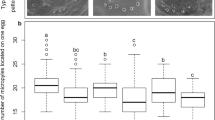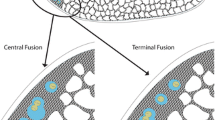Abstract
This is the first report of gynandromorphy in Isoptera. An Asian dry-wood termite, Neotermes koshunensis (Shiraki) [Kalotermitidae], possessing both male and female phenotypic characteristics, was found on Okinawa Island, Japan. This deformed individual showed morphological and anatomical hermaphroditism in the abdomen. The right side of the seventh sternite was the female form and contained an ovary, while the left side was the male form and contained a testis. Genotypic analysis revealed that this individual was a genotypic bilateral chimera. These results suggested that the termite was a bilateral gynandromorph with a male left side and a female right side. As reported previously in other insects, double fertilization (by two sperms, one with an X and one with a Y chromosome) of a binucleate egg is the most likely mechanism that generated this genotypic bilateral chimera. N. koshunensis has the ability to reproduce through parthenogenesis, in which the secondary polar body is likely to be used for nuclear phase recovery. If the second polar body in this mechanism has high fertility and healthy embryogenic potential, like an egg nucleus, some of gynandromorphs might be produced by a side effect of parthenogenetic ability.


Similar content being viewed by others
References
Agate RJ, Grisham W, Wade J, Mann S, Wingfield JC, Schanen C, Palotie A, Arnold AP (2003) Neural, not gonadal, origin of brain sex differences in a gynandromorphic finch. Proc Natl Acad Sci U S A 100:4873–4878
Barth RH, Bell WJ (1971) Reproductive physiology and behavior of Byrsotria fumigata gynandromorphs (Orthoptera (Dictyoptera): Blaberidae). Ann of Entomol Soc Am 64:874–879
Brodkorb P (1935) A sparrow hawk gynandromorph. Auk 52:183–184. doi:10.2307/4077214
Geyer JWC (1951) The reproductive organs of certain termites, with notes on the hermaphrodites of Neotermes. Union of South Africa, Department of Agriculture. Entomol Memoirs 2:233–325
Grandi G (1990) Oogenesis in Kalotermes flavicollis (Fabr.) (Isoptera, Kalotermitidae) III. Choriogenesis and corpus luteum formation in female supplementary reproductives. Boll Zool 57:97–107. doi:10.1080/11250009009355683
Graves RC, Yoon JS, Durbin EJ (1986) A gynandromorph in the Madagascar hissing cockroach, Gromphadorhina portentosa (Blattodea: Blaberidae). Ann of Entomol Soc Am 79:662663
Kobayashi K, Miyaguni Y (2016) Facultative parthenogenesis in the Ryukyu drywood termite Neotermes koshunensis. Sci Rep 6:30712. doi:10.1038/srep30712
Laranjo LT, Costa-Leonardo AM (2017) First record of intersex in neotenic reproductives of the termite Cryptotermes brevis (Isoptera: Kalotermitidae). Entomol Sci 20:142–149
Luykx P (1990) A cytogenetic survey of 25 species of lower termites from Australia. Genome 33:80–88
Matsuura K (2011) Sexual and asexual reproduction in termites. In: Bignell DE, Roisin Y, Lo N (eds) Biology of termites: a modern synthesis. Springer, Dordrecht, pp 255–277
Mitchell JC, Fouquette MJ Jr (1978) A gynandromorphic whiptail lizard, Cnemidophorus inornatus, from Arizona. Copeia 1978:156–159
Miyaguni Y, Sugio K, Tsuji K (2012) Refinement of methods for sexing instars and caste members in Neotermes koshunensis (Isoptera, Kalotermitidae). Sociobiology 59:1217–1222
Narita S, Pereira RAS, Kjellberg F, Kageyama D (2010) Gynandromorphs and intersexes: potential to understand the mechanism of sex determination in arthropods. Terr Arthropod Rev 3:63–96
Patten MA (1993) A probable bilateral gynandromorphic black-throated blue warbler. Wilson Bull 105:695–698
Ross MH, Cochran DG (1967) A gynandromorph of the German cockroach, Blattella germanica. Ann of Entomol Soc Am 60:859–860
Scriber JM, Mercader RJ, Romack H, Deering MD (2009) Not all bilateral gynandromorph butterflies are interspecific hybrids: new Papilio specimens from field populations. J Lepid Soc 63:37–47
Thompson CB, Snyder TE (1920) The “third form,” the wingless reproductive type of termites: Reticulitermes and Prorhinotermes. J Morphol 34:590–633
Tulgetske GM, Stouthamer R (2012) Characterization of intersex production in Trichogramma kaykai infected with parthenogenesis-inducing Wolbachia. Naturwissenschaften 99:143–152
Weesner FM (1969) External anatomy. In: Krishna K, Weesner FM (eds) Biology of termites vol. 1. Academic Press, New York, pp 19–47
Yashiro T, Matsuura K (2014) Termite queens close the sperm gates of eggs to switch from sexual to asexual reproduction. Proc Natl Acad Sci U S A 111:17212–17217
Acknowledgments
We thank S. Dobata and anonymous referees for their helpful advices. This work was supported by the Grant-in-Aid for the research fellows of Japan Society for the Promotion of Science to Y.M. (No. 14J02030) and T.N. (No. 16J08955).
Author information
Authors and Affiliations
Corresponding author
Additional information
Communicated by: Sven Thatje
Rights and permissions
About this article
Cite this article
Miyaguni, Y., Nozaki, T. & Yashiro, T. The first report of gynandromorphy in termites (Isoptera; Kalotermitidae; Neotermes koshunensis). Sci Nat 104, 60 (2017). https://doi.org/10.1007/s00114-017-1478-0
Received:
Revised:
Accepted:
Published:
DOI: https://doi.org/10.1007/s00114-017-1478-0




